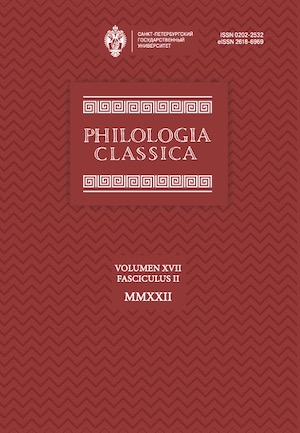Latin Impersonal Passive and the Category of Pluractionality
DOI:
https://doi.org/10.21638/spbu20.2022.208Abstract
This article aims to put Latin impersonal passive into the context of covert categories, specificallypluractionality. I try to reanalyse six passages from the Roman grammatical texts, mostly compiled in Heinrich Keil’s Grammatici Latini, in which the meaning of Latin impersonal passives is considered. There are two groups of evidence. The first one (passages from Diomedes, Priscian, and frg. Bobiense de verbo) presents the impersonal passive as a linguistic strategy that shifts focus from an agent to a situation, while the second one (Diomedes and two excerpts of Servius’ commentaries on Virgil) concentrates upon the number of agents. In the last case, a verbal action is considered to be a collective one involving many people, and therefore, in my opinion, falls into the category of pluractionality. Being a diverse phenomenon, the term pluractionality includes participant plurality, which is realised either in a subject or in an object depending on whether the verb is intransitive or transitive. Intransitivity of the Latin impersonal passive forms, as it seems, may imply agent plurality rather than subject plurality, since impersonal passive constructions are subjectless. Furthermore, in my opinion, the evidence provided by Latin grammarians demonstrates a contraposition of the 1st personsingular, 1st person plural and 3rd person singular passive forms.
Keywords:
Latin, pluractionality, agent plurality, subject plurality, covert category, impersonal passive, Roman grammarians
Downloads
References
Downloads
Published
How to Cite
Issue
Section
License
Articles of "Philologia Classica" are open access distributed under the terms of the License Agreement with Saint Petersburg State University, which permits to the authors unrestricted distribution and self-archiving free of charge.






